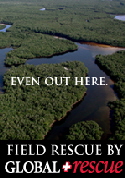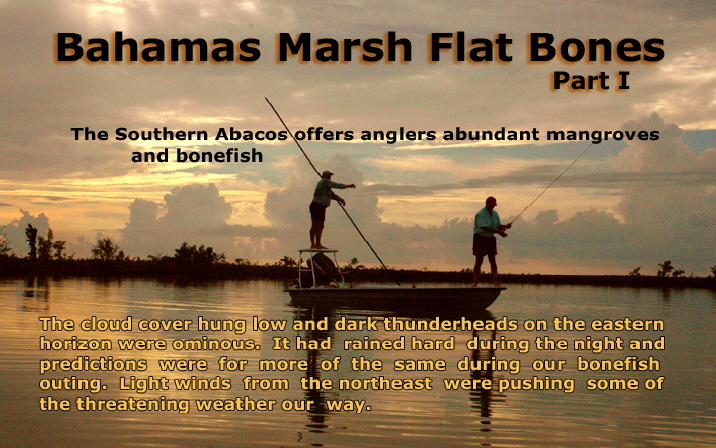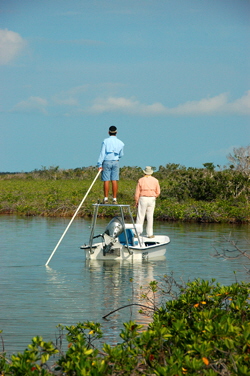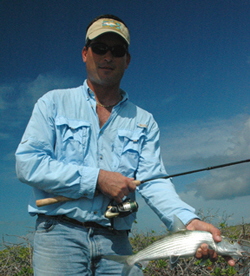 |
||||||||||||
|
|
||||||||||||
|
|
||||||||||||
|
|
||||||||||||
|
|
||||||||||||
|
|
||||||||||||
|
|
||||||||||||
|
|
||||||||||||
|
|
||||||||||||
|
|
||||||||||||
|
|
||||||||||||
 |
||||||||||||
 |
||||||||||||
|
|
||||||||||||
|
|
||||||||||||
 |
|
|
|
|
When stalking bones, cloud cover can be a double-edge sword. You can get much closer to the fish without them becoming overly-cautious. But you cannot see them as well at long distances. As a result, three singles and two small schools of bones were just off the bow before my guide and I spotted them. A few casts to each seemed to be neglected or outright avoided. They swam around the offerings and sprinted away from our boat. Avid bonefish fly fisherman Dan Armitage and I were fishing about 200 yards apart with guides Buddy Pinder and Jody Albury in their two skiffs. Dan was stripping a Pinder-tied bonefish fly through the flats, and I was tossing both real shrimp and Berkley Gulp shrimp artificials on a hook sans weight with my lightweight spinning tackle. The bones were equal-opportunity "neglectors." "Fish on!" Buddy shouted from his perch above Dan whose bent 8-weight rod revealed action after some 45 minutes of bonefish teasing. His reel sang a sweet melody as the two-pounder made its way around the small mangrove-lined cove. The fish was a nice ice-breaker.
A couple came back through the 12 inch deep trough we were in and a few more casts seemed to scare them further. "Let's move on around this point and leave that small cove for those guys," my guide advised. Albury, who has fished the Bahamas Out Islands for bones about seven years and has been guiding anglers in the marsh for over 5 years, poled our skiff around the mangrove point to a favorite spot of his. The cove "necked down" to a 20-foot wide cut. Beyond that, the water split into three channels that narrowed further and disappeared into the flooded mangroves after about 20 feet. "There's movement in that cut," he pointed out as we neared the spot. "See them back at the edge of the mangroves? There must be 50 or more there."
Like a small, out of control freight train, the bonefish burst 15 feet back into the flooded mangroves, turned and then streaked through another seven huge clumps of mangrove bush. My 20 pound test Power Pro braid was intertwined into the maze of bushes, but the fish was still on. I knew that I would never be able to drag the bonefish 40 yards back out of the entanglements the same way that it had swam in. There was no way. The fish seemed to wallow in shallow water far back into the mangroves but it couldn't move far at this point. Jody acted quickly and jumped down from the poling platform. He slid into the water and made his way back into the mangroves toward the fish. A few minutes later, he grabbed the 3-pound fish and held it up for me to admire. The bonefish was about average for the area we were fishing. Most of the fish in the schools there weigh 2 to 4 pounders and average school size may be 20 to 30 although there may be as many as 400 fish in a large school. The fish typically peel off the school and swim out of the confining pockets. During normal water conditions in the marsh, the bonefish don't hang out in the mangroves, according to Jody. Then, at high tide, the fish move into the fresh feeding grounds of the mangroves. When the tide is coming out of the mangroves, the fish will move out also and you can catch them more easily. When they're feeding and moving, get in their path line to catch them. "On a typical full day of fishing, the angler will usually catch between 4 and 14 bonefish depending on their ability with spinning tackle," says the guide. "Fly fishing numbers may be twice as high. The fish here are more susceptible to a fly than a shrimp or bait. With bait shrimp and spinning gear, the angler places the enticement in front of the fish and waits for them to move in and hit." Jody's clients have caught bonefish up to over 8 pounds. Muds and the feeding bonefish causing them in the marsh are not uncommon. You can occasionally find them where schools of 2 to 4 pound bonefish are feeding along the bottom, according to the guide. The guide's best day with one angler client was 28 bonefish up to 5 pounds, and like most places, as the average size goes up, the quantity goes down. There are certain areas in the marsh where an angler can catch larger average-sized fish but they are harder to catch, according to Jody. There, the numbers of fish may drop considerably. "At other areas such as Cherry Key, Sandy Point or Snake Key, the bones average 4 to 6 pounds," he points out, "but there are not as many fish in those places. There are some 8 to 12 pound fish in those areas as well."
For those looking for a guide with trailered skiff, the Abaco Beach Resort offers 4-day, 3-night ocean front accommodations overlooking the picturesque Sea of Abaco with 2 1/2 days of bonefishing with guide and round-trip transfers from the airport. The upscale resort offers 88 luxurious rooms and cottages and the island's best restaurant, Anglers, two pools and other great facilities spread out on 52 acres of beautifully landscaped ocean front. Scuba diving, offshore charter boat fishing and tours to nearby Hope Town are also available to guests. To find out more information on the bonefish packages offered by Abaco Beach Resort & Boat Harbour in the Bahamas Out Islands, contact 1-800-753-9259 or visit their website at www.abacobeachresort.com. To contact Jody Albury Bonefishing Charters, phone 242-367-5119 or email captjea@hotmail.com.
|
|
|
|
|
|


 "Seven other bones are heading your way," Buddy shouted to Jody. We waited at the tiny neck of the cove and sure enough, they pushed into it toward us.
Jody saw their slight wakes first and directed me where to cast. My bait landed about 4 feet in front of them. The small pack separated and went around it as I slowly twitched the shrimp. They moved up to our
boat and then rapidly sped off in several directions.
"Seven other bones are heading your way," Buddy shouted to Jody. We waited at the tiny neck of the cove and sure enough, they pushed into it toward us.
Jody saw their slight wakes first and directed me where to cast. My bait landed about 4 feet in front of them. The small pack separated and went around it as I slowly twitched the shrimp. They moved up to our
boat and then rapidly sped off in several directions. Indeed, a large school was working the bottom in and around the flooded mangroves at the end of the three tiny channels. As we neared,
a dozen or more split off the main pack of bones and started to feed toward our now stationary position. I placed my cast 8 feet in front of
the school and waited. I barely twitched it and two fish moved by but a third bolted toward the bait and grabbed it. I set the hook.
Indeed, a large school was working the bottom in and around the flooded mangroves at the end of the three tiny channels. As we neared,
a dozen or more split off the main pack of bones and started to feed toward our now stationary position. I placed my cast 8 feet in front of
the school and waited. I barely twitched it and two fish moved by but a third bolted toward the bait and grabbed it. I set the hook. While the large "grey ghosts" may be very spooky, smaller, more aggressive bones may be easy to contact in the marls. If you put a lure,
bait or fly where it needs to be in front of them, the fish will eat it. They are not too choosy at all when they are hungry, according to the guide,
who has even seen bonefish turn upside down to inhale a moving bait near the surface!
While the large "grey ghosts" may be very spooky, smaller, more aggressive bones may be easy to contact in the marls. If you put a lure,
bait or fly where it needs to be in front of them, the fish will eat it. They are not too choosy at all when they are hungry, according to the guide,
who has even seen bonefish turn upside down to inhale a moving bait near the surface!